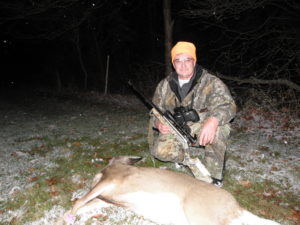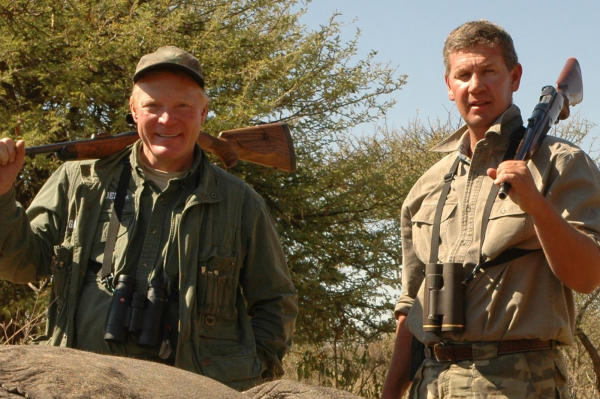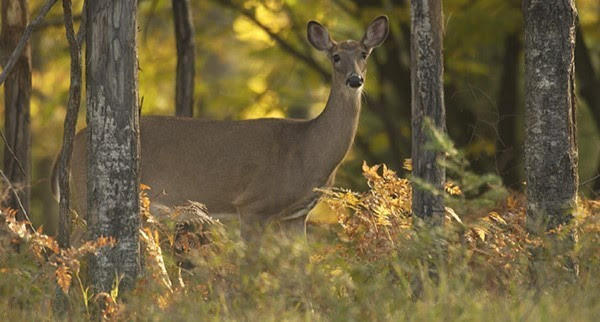Late Season Care of Deer After the Shot
By Glen Wunderlich
The final three weeks of deer hunting seasons are under way and some hunters actually prefer the late seasons of muzzleloading and antlerless deer hunting to get those freezers filled. Although less deer are certainly present and that fact may offer fewer opportunities, less hunting pressure and the probability of snow on the ground and colder temperatures can be good or bad depending on how hunters are prepared. Good table fare begins with good preparation – both afield and at home.
I am one of those hunters that looks forward to our generous late seasons, because a return to normalcy is a return to predictability. Colder weather means that deer must consume more food to fight the elements; find food and find the deer. Being prepared, however, means more than dressing with warm clothes and includes a plan after the shot.

Late-season doe
Failure to care for the meat from field to freezer can spell the difference between good and bad meat. As is typical for this time of year in Michigan, night temperatures are below 32 degrees or freezing. Therefore, hunters not only want to recover deer before they have a chance to freeze, they also do not have the luxury of hanging deer to cool them without freezing or to age the meat. We do not want an unprocessed deer to freeze before the butchering operation, because it will have to be thawed before packaging and freezing, once more. Done improperly, the meat can not only have an offensive taste, it can be downright spoiled with bacteria and that can cause illness.
Says Tina Hanes, a registered dietitian with the United States Department of Agriculture’s Food Safety and Inspection Service, “Any raw or cooked food that has been thawed can be refrozen as long as it was thawed properly — in the refrigerator, not on the counter — and hasn’t spoiled. “Thawed properly” does not include the use of any heaters or placing the meat in room temperature. Bacteria likes the warmer temperatures and that’s where it may become unsafe.
“You can refreeze anything as long as it’s been handled properly,” Ms. Hanes said, adding that it is safe to thaw and then refreeze frozen fruit, vegetables, breads, cakes, processed foods and other items. The process, however, may affect their texture, taste and color, making them mushy or dried out and less appetizing, depending on the item. Refreezing, therefore, should be avoided even if it is safe.
Venison is one of those items that becomes less appetizing, even if refreezing was done “properly.” Freezing food is a convenient method of preservation, yet it can cause the quality of the food to deteriorate. To ensure that your meat is free from trichina and other parasites, always cook meat thoroughly.
Whether fresh, previously frozen or cooked, meat stored at zero degrees Fahrenheit or lower is safe provided it was safe when frozen. At freezing temperature, mold, bacteria and yeast molecules slow down and microbes become dormant. Preventing the microbes from growing preserves food, as they are the cause of spoiled food and resulting illnesses. Freezing meat won’t significantly change its nutritional content. Freeze it as quickly as possible to prevent the formation of ice crystals.
Wrap meat well to prevent freezer burn. Spread packages to freeze in a single layer on the freezer’s shelves and stack them after frozen.
While we cannot control the weather, we can arrange to get our prized venison into a walk-in cooler in advance. It will make all the difference later.




 Thoughtfully designed, this compact, all-in-one kit features everything from well-placed posts to secure the animal’s legs in an ideal gutting position, to rib hooks and a set of knives, all secured in a durable scabbard.
Thoughtfully designed, this compact, all-in-one kit features everything from well-placed posts to secure the animal’s legs in an ideal gutting position, to rib hooks and a set of knives, all secured in a durable scabbard.
 Pat Palmer, inventor of the GutDaddy and CEO of Dark Moon Hunting, has a passion for hunting and the outdoors and a desire to share that with others.
Pat Palmer, inventor of the GutDaddy and CEO of Dark Moon Hunting, has a passion for hunting and the outdoors and a desire to share that with others. During creation of the GutDaddy, Palmer focused on making a strong and durable all-in-one case that encompassed everything a hunter would need to get the job done.
During creation of the GutDaddy, Palmer focused on making a strong and durable all-in-one case that encompassed everything a hunter would need to get the job done. “In addition to making the field-dressing process easier, safer and faster, the GutDaddy provides a safe way to teach new hunters how to field dress a large animal,” Palmer said. “It also creates independence for physically challenged hunters. Without a doubt, this tool will assist hunters of all ages, all levels of experience and those with physical challenges.”
“In addition to making the field-dressing process easier, safer and faster, the GutDaddy provides a safe way to teach new hunters how to field dress a large animal,” Palmer said. “It also creates independence for physically challenged hunters. Without a doubt, this tool will assist hunters of all ages, all levels of experience and those with physical challenges.”